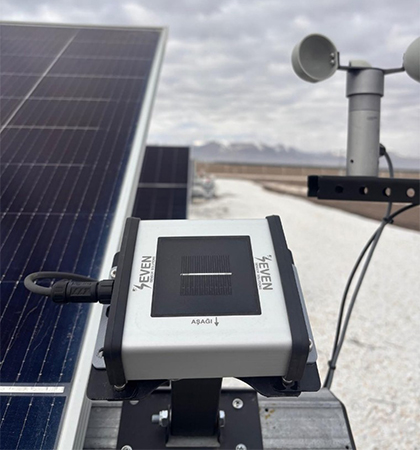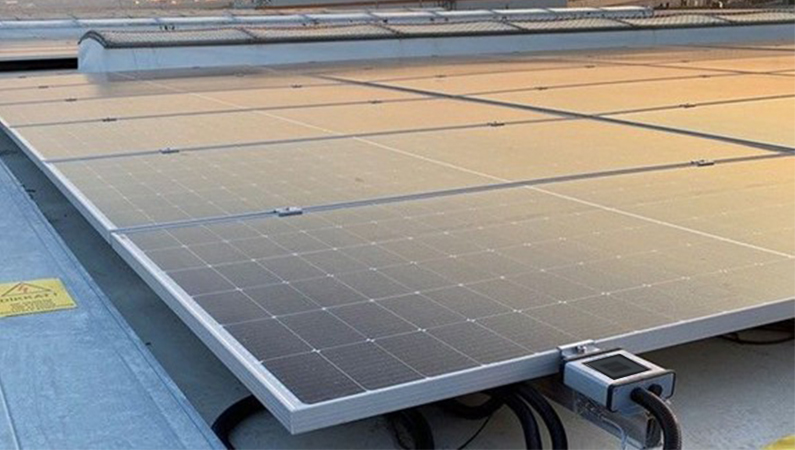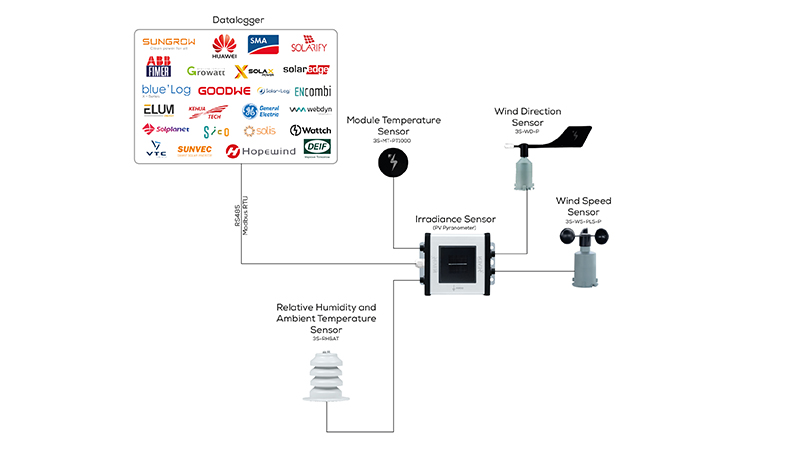Irradiance Sensor With Modbus RTU Output – 3S-IS
The 3S-IS Irradiance Sensor is designed for solar PV plants that require accurate irradiance and cell temperature measurement with Modbus RTU communication. Delivered with a mounting bracket and cable, this UV-protected, plug-and-run sensor integrates easily into existing PLC, SCADA, or datalogger systems via RS485.
TECHNICAL SPECIFICATIONS OF IRRADIANCE SENSOR
| Item Code | 3S-IS, 3S-IS-1, 3S-IS-2, 3S-IS-2T, 3S-IS-3, 3S-IS-4, 3S-IS-5 |
| Reference Cell | Monocrystalline Silicon (31 mm x 31 mm) |
| Current Shunt | High precision shunt resistor directly soldered to the terminals of the cell |
| Irradiance Range | 0 – 1600 W/m² |
| Uncertainty | ≤1%, as per IEC61724-1 standard Class A |
| Resolution | 0.1 W/m², as per IEC61724-1 standard Class A |
| Response Time | 1 sec. as per IEC61724-1 standard Class A |
| Drift | Very small drift of <0.3%/ year |
| Field of View | Larger than 160° as per IEC61724-1 standard Class A |
| Tilt-Azimuthal Angle | 0°- 0° , ≤ 1°; as per IEC61724-1 standard Class A |
| Output Rate | 1/s |
| Data Output | RS485 up to 38400 Baud |
| Communication Protocol | Modbus RTU |
| Power Supply | 12 to 30 V DC |
| Power Consumption | 30 mA max @24 VDC |
| Electrical Connection | 3 m LIYYC11Y PUR Cable, UV and Weather Resistant |
| Galvanic Isolation | 1000 V between power supply and RS485 bus |
| Cell Temperature Sensor Type | PT1000 Class A as per EN 60751 |
| Operating Temperature Range | -40°C to +85°C |
| Operating Humidity Range | 0 to 100 % |
| Box Dimensions | 140 mm x 110 mm x 42 mm (W x L x H) |
| Weight | 0.3 kg |
| IP Rating | IP54 (IP65, IP68 options) |
| Sensor Housing Material | Aluminum |
| Compliant Standard | IEC 61724-1:2021 and IEC 60904 |
| Calibration | Each sensor is calibrated under Class AAA Sun Simulator as per IEC 60904-2 and IEC 60904-4 by using a reference cell calibrated by ISFH-Germany |
| Test | The test is carried under natural sunlight by using a calibrated reference cell from Fraunhofer ISE, Germany |
What Does an Irradiance Sensor Do?
Solar irradiance is the amount of solar power received per unit area (W/m²). Monitoring irradiance is essential for evaluating the performance of PV plants. The 3S-IS sensor measures irradiance using a monocrystalline silicon solar cell, while also compensating for temperature effects thanks to its built-in PT1000 cell temperature sensor.

How Does the 3S-IS Sensor Work?
- A monocrystalline solar cell absorbs sunlight and generates current.
- A precision shunt resistor converts this current into measurable signals.
- The temperature sensor at the back of the cell corrects deviations caused by heat.
- An electronic card processes these signals and calculates compensated irradiance values in W/m².
- Data is sent to receiver units via RS485 using Modbus RTU.
Because of its flexible design, the 3S-IS can also link with additional environmental sensors, turning it into a complete monitoring hub for PV plants.
Why Choose the 3S-IS Irradiance Sensor?
- Trusted accuracy: IEC 61724-1 Class A compliance with uncertainty ≤1%, calibrated as per IEC 60904-2 standards.
- Fast results: Response time of one second for real-time decision making. It can be reduced to 500 milliseconds upon request.
- Built to last: A UV-protected IP54 aluminum housing with optional IP65/IP68 ensures reliable operation in demanding outdoor environments.
- Quick setup: Plug-and-run design means fewer installation errors and faster commissioning. Supplied with mounting bracket and cable. Easy integration with any Modbus-compatible PLC, SCADA, or datalogger.
- Expandable: Supports connection of multiple external sensors (temperature, wind, humidity) for more complete monitoring.

Available Models of the 3S-IS Irradiance Sensor

All models below are IEC 61724-1:2021 Class A compliant, factory-calibrated, and built with the same durable construction. The only difference is the number and type of external sensors that can be connected via RS485 Modbus RTU.
| Model | Communication | Uncertainty | External Sensor Options |
| 3S-IS | RS485 Modbus RTU | ≤1%, as per IEC61724-1 standard Class A | No external sensor can be connected |
| 3S-IS-1 | RS485 Modbus RTU | ≤1%, as per IEC61724-1 standard Class A | Ambient Temperature Sensor OR Module Temperature Sensor |
| 3S-IS-2 | RS485 Modbus RTU | ≤1%, as per IEC61724-1 standard Class A |
Ambient Temperature Sensor OR Module Temperature Sensor
Wind Speed Sensor
|
| 3S-IS-2T | RS485 Modbus RTU | ≤1%, as per IEC61724-1 standard Class A |
Ambient Temperature Sensor
Module Temperature Sensor
|
| 3S-IS-3 | RS485 Modbus RTU | ≤1%, as per IEC61724-1 standard Class A |
Ambient Temperature Sensor
Module Temperature Sensor
Wind Speed Sensor
|
| 3S-IS-4 | RS485 Modbus RTU | ≤1%, as per IEC61724-1 standard Class A |
Ambient Temperature Sensor
Module Temperature Sensor
Wind Speed Sensor
Wind Direction Sensor OR Relative Humidity Sensor
|
| 3S-IS-5 | RS485 Modbus RTU | ≤1%, as per IEC61724-1 standard Class A |
Module Temperature Sensor
Wind Speed Sensor
Wind Direction Sensor
Relative Humidity and Ambient Temperature Sensor
|
Frequently Asked Questions (FAQ)
1- Which datalogger brands are SEVEN irradiance sensors compatible with?
SEVEN irradiance sensors are compatible with a wide range of well-known datalogger brands, including:
- ABB
- Bluelog
- DEIF
- Elum
- Encombi
- Fimer
- General Electric
- GoodWe
- Growatt
- Hopewind
- Huawei
- Kehua Tech
- Sico
- SMA
- Solplanet
- SolarEdge
- Solar-Log
- SolaX Power
- Solis
- Sungrow
- SUNVEC
- Wattch MET
- Webdyn
2- What is the uncertainty of the irradiance sensor?
The uncertainty is ≤1%, fully compliant with IEC 61724-1 Class A requirements.
3- Can this sensor connect directly to my SCADA system?
Yes, as long as your system supports RS485/Modbus RTU, the sensor will be fully compatible.
4- How are the sensors tested and calibrated?
Each irradiance sensor is calibrated under a Class AAA Sun Simulator as per IEC 60904-2 and IEC 60904-4, using a reference cell calibrated by ISFH-Germany.
The sensors are tested in natural sunlight against a reference cell calibrated by the Fraunhofer ISE Institute.
5- How often should I recalibrate the sensor?
Recalibration every 2 years is recommended by IEC standards for maximum accuracy.
6- Where can I recalibrate the irradiance sensor?
SEVEN Sensor provides calibration services at its facilities. Calibration is performed using a Class AAA Sun Simulator, in accordance with IEC 60904-2 and IEC 60904-4 standards, and referenced against a calibration cell certified by the ISFH Institute in Germany.
Additionally we offer user-friendly interface where users can recalibrate the sensors in their home country and enter the new calibration values into the system.
7- Are the irradiance sensors Class A?
Yes. All SEVEN irradiance sensor models — 3S-IS, 3S-IS-1, 3S-IS-2, 3S-IS-2T, 3S-IS-3, 3S-IS-4, and 3S-IS-5 — are Class A as per IEC standards, with the exception of the low-cost irradiance sensor.
8- What is the price of irradiance sensors?
Depending on the model and included accessories, the 3S-IS series is available between 300 and 600 EUR.
9- Does the sensor include a cable?
Each unit comes with a 3 m LIYYC11Y PUR cable (UV and weather resistant) with 6 wires twisted (including ground for both Data & Power). Other lengths are available on request.
10- What makes this sensor different from analog models?
Unlike analog outputs, Modbus RTU provides digital communication, minimizing signal loss over long distances and allowing multi-sensor connections.
11- What are the delivery times?
- Small orders: approx. 3-5 days
- Bulk orders (100 pcs): approx. 4-6 weeks
12- How do I set up the sensor?
Follow our user manual, setting instructions and YouTube video guides, which include step-by-step instructions for configuring the sensors with well-known datalogger brands such as SMA, Huawei, and Sungrow. We also provide remote setup support if needed.
13- What is the warranty?
All 3S-IS sensors come with a 5-year warranty.
14- What external sensors can be connected to the irradiance sensor?
The SEVEN irradiance sensor can also function as a hub, supporting the connection of external sensors such as:
- Module temperature sensors
- Ambient temperature sensors
- Wind speed sensors
- Wind direction sensors
- Relative humidity sensors

